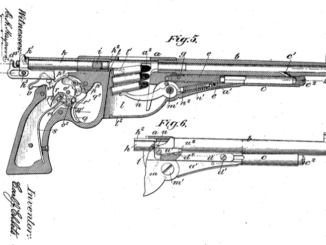Today we are out at the range with the .45 ACP Steyr-Solothurn MP-34. I was curious to see how this submachine gun, much more commonly found in 9mm, would handle with the big .45 caliber cartridge. The answer? Quite nicely! It has a slightly lower rate of fire than the same gun chambered for 9x23mm Steyr, and is very pleasant to shoot.
Related Articles

Bolt Action Rifles
Fake Nazi Marked Steyr M95
What is the fastest way to add a couple hundred bucks to the price of a WWII-era firearm? Add a Waffenamt to it, of course! German markings on a gun always drive up interest and […]

Bergmann
Carl Ehbet’s Gas Operated Bergmann?
I got a really interesting patent in my mail recently, from Othais at C&Rsenal. It’s and idea clearly based on a Bergmann 1894 or 1896 pattern pistol, but instead of being blowback it uses a […]

Commentary
Bergmann 1894 Grip Style
I recently had the opportunity to examine a very early model 1894 Bergmann pistol, and made an interesting discovery (discovery to me, at any rate). The gun has a rather elegant bird’s-head grip, and a […]

What some would not have given to produce this in America… Oh, wait, Auto Ordnance wouldn’t be too happy about that. And yet again, this was intended for a right handed user. What would be the ideal reloading cycle for this?
“(…) What would be the ideal reloading cycle for this?”
Used example do not have forward pistol grip as what https://guns.fandom.com/wiki/Steyr-Solothurn_S1-100
show as .45 ACP version of the S1-100 (Model 1934) with foregrip
according to https://modernfirearms.net/en/submachine-guns/austria-submachine-guns/steyr-solothurn-mp-34-eng/
For South American markets, Steyr produced version of S1-100 in .45 ACP caliber; this version was distinguished by additional pistol grip under the forearm.
which imply it was default for weapons made for South America.
How it would affect handling?
The slow motion video seems to agree with your theory. When the bolt goes all the way back to the end of its travel, the bolt handle gives a little flick. And with most .45 shots, no flick. Interesting!
…NYPD chucked ’em into the sea?! Good grief…
Waste of good weaponry unless they ran out of spare parts…
Forget it Jake, it’s New York.
Open bolt firing sub machine guns have many of the features of constant recoil actions. Since the firing pin is fixed to the bolt, cartridge ignition is dependent on bolt speed. The bolt has an extra long travel from sear release to chambering to get the speed up. After firing, when the bolt is moving back it has enough travel for the recoil spring to slow and stop bolt movement before it hits the receiver. This also cuts the cyclic rate way down (50%?), also improving controlability.
The firing-on-bolt-closing is another element. As the cartridge fires the bolt is crashing into the back of the barrel which throws the gun forwards to help reduce recoil. you can see this when the gun runs empty, the gun will lurch forward.
As always, thanks for bringing us another Forgotten Weapon, especially the live fire videos.
In many of those early SMGs including the MP-34 firing pin is not fixend to the bolt. It does not harm to your “semi-constant recoil” description but is a technical inaccuracy
It remains only to understand what kind of beast this “constant recoil action” is. 😉
Sounds like a “triple action revolver.”